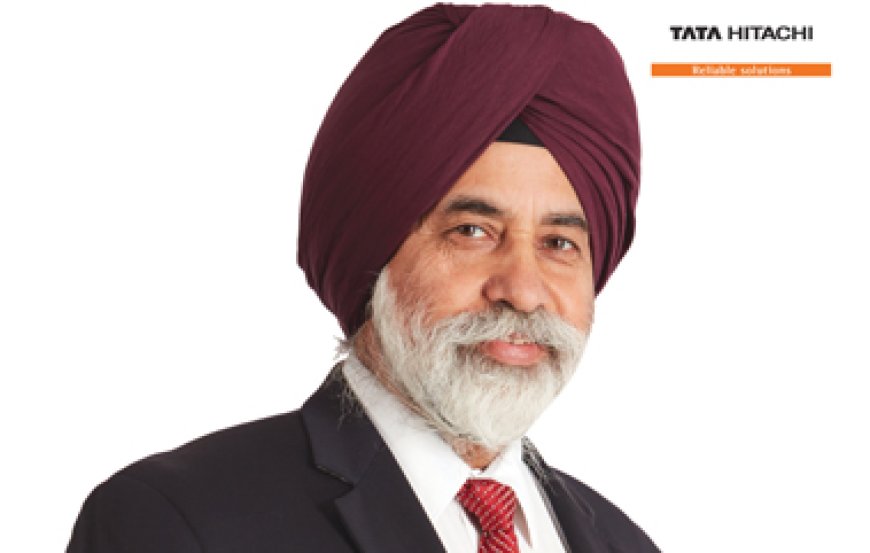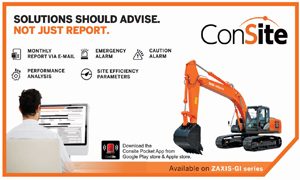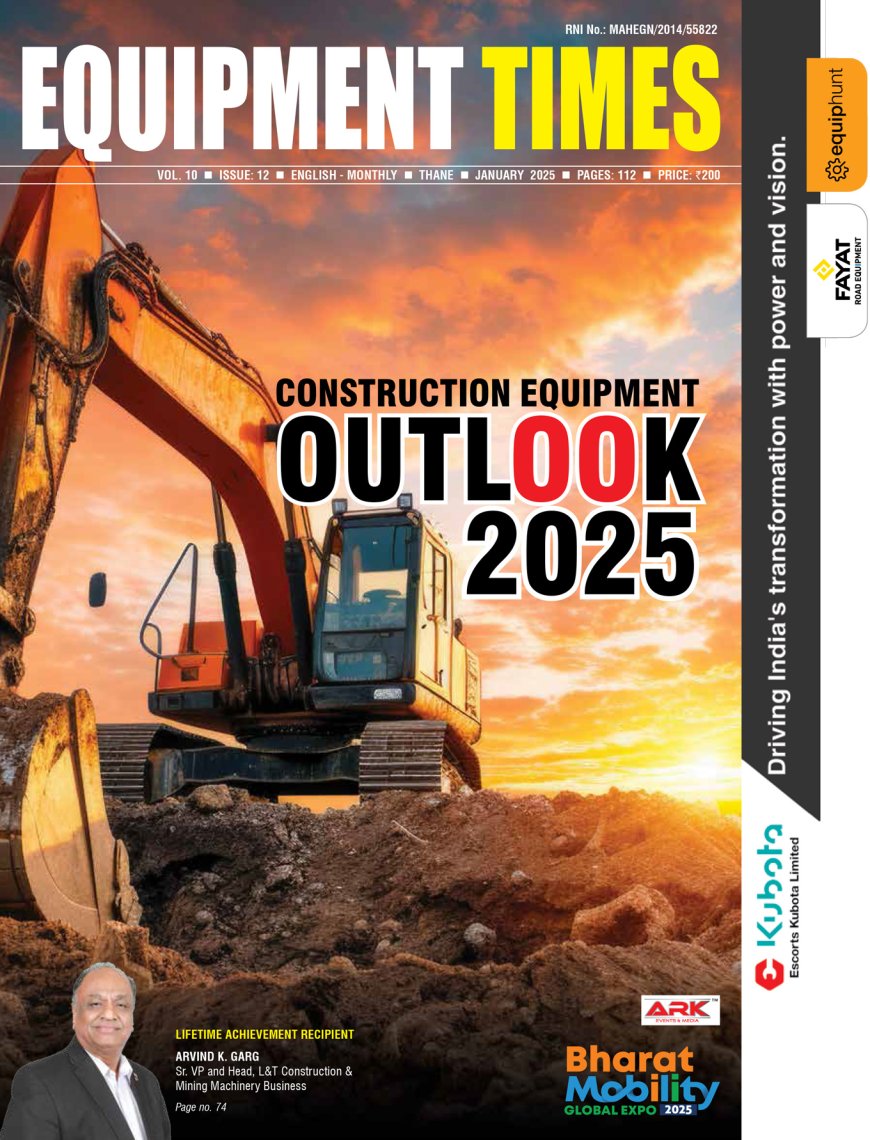Our telematics solutions help in identifying areas for improving productivity.
Sandeep Singh, Managing Director, Tata Hitachi. Tata Hitachi has been developing new solutions in the field of telematics and data analytics. Tata Hitachi is increasingly working on reducing dependence on human expertise as a factor for service recommendations and

 Sandeep Singh,
Sandeep Singh,
Managing Director,
Tata Hitachi.
Tata Hitachi has been developing new solutions in the field of telematics and data analytics.
Tata Hitachi is increasingly working on reducing dependence on human expertise as a factor for service recommendations and service delivery and we see the future is just filled with ever more exciting possibilities. In an exclusive chat with Equipment Times Sandeep Singh, Managing Director, Tata Hitachi shares his views on the solutions offered by the company in the telematics space.
Could you spell out the vision of Tata Hitachi in imbibing and leveraging the advantages of digital platforms?
At Tata Hitachi, our vision is to delight our customers with an integrated service. To do this, we necessarily need to be aware of the way our customers use their machines: the various applications the machines are used in, through various points in their ownership lifecycle. This helps us hone our ability to offer relevant products and services to our customers at appropriate times.
However, the use of technologies on a standalone basis is still to gain wide spread acceptance amongst customers. Our attempt therefore, is to popularize the end use / benefit of technology through intensive trainings. As the systems mature and their use increases, we will look at integration tools that straddle multiple standalone systems to generate combined solutions.
 Could you give couple of examples from any of your product range where telematics have brought a transformational value to the end-user / industry?
Could you give couple of examples from any of your product range where telematics have brought a transformational value to the end-user / industry?
Today, telematics has helped the customer monitor his machines and operations sitting in the comfort of his office or home. The analysis built around the data that telematics offers, gives the customer insightful information that helps him identify whether the operations are going as per plan or if some intervention is required.
Telematics also recommends on which areas of operation to focus on and how. The machine informs the customers and the dealer of any emergency situation or a potential problem. The dealer is then adequately prepared to resolve the issue at the earliest.
All this has transformed the way the modern construction sites are functioning, enabling customers to improve system efficiencies, schedule maintenance interventions, reduce unplanned breakdowns and maximise equipment and site utilization.
What is the impact of big data analytics and telematics on the nature of repair and maintenance services? Could you site couple of examples from any of your product category?
The world is moving from the premise of time based maintenance to condition or data based maintenance. For this, telematics and data analytics are proving to be extremely helpful. At Tata Hitachi, our Zaxix GI series excavators are equipped with Global e Service, an offering based on the platform developed by Hitachi, Japan. On this is layered a premium offering called Con Site, which we offer as a standard with all our GI machines. ConSite uses years of experience, comparative data of similar class machines operating in the region and provides insightful advice and recommendations to improve operations. There is also an alarm service which uses machine events and is an intelligent filter to communicate machine breakdown and raise caution alarms with due recommendation to the customer and to the dealer for appropriate action. Our consultative approach to examining and advising customers on the health of their machines is a major value added support to our customers.
InSite is our home grown IoT solution that provides key operational, maintenance, location, and health data of the machine to the customers and Tata Hitachi.
What is the impact of these technologies on safety of men and machines?
Tata Hitachi’s telematics suites offer additional safety to the already safe machines. Critical conditions like overloading, engine overheating, higher digging or travel load are tracked meticulously through ConSite and InSite. If left unattended, these can cause damage to men and machines. Hence, through telematics, information is provided to the right site personnel to take preventative actions as and when such issues arise.
What is the impact of the same on the cab and on the operators? How these technologies help enhancing the productivity thereby lowering the TCO?
Tata Hitachi’s telematics solutions help in identifying areas for improving productivity by monitoring machine operations. Performance in these areas is then graded with respect to benchmarked data to show the potential improvement. This helps improve the TCO for the machine owner.
What do you think the major challenges when it comes to adopting the digital platforms?
Some of the major challenges with respect to use of telematics in the equipment is the availability of seamless network connectivity. There is still need to improve connectivity across the hinterland in the country. To combat this, we have equipped the machines with onboard memory to capture data in itself during these ‘signal blackouts’ so that whenever the machines are back in the network, they can update all the information to the servers.
Another challenge is the adoption of such advanced technologies by the mass market machine users. For this we are engaging more deeply with the customers and demonstrating the long term benefits of the advanced systems in reducing the costs and improving productivity for the customers.
Data privacy, hacking concerns, installation costs, and overall internet connectivity strength could negatively impact the rate of growth in this area? What is your take on these and how have you been addressing these concerns?
Information privacy is a critical concern these days and Tata Hitachi addresses this by harnessing the expertise of Hitachi’s information security systems and procedures to keep the highest levels of safety. The robust standards of Hitachi ensure that our systems and servers are kept safe.
Regarding poor connectivity, Tata Hitachi systems use multiple service providers and data storage capability that help in tiding over patchy networks.
What is the customer expectation from big data analytics / telematics service from various end-user segments?
There is an emerging interest in customers to understand the usage patterns of the machines they own. Their health conditions, maintenance requirements and possibility of improvement in utilization is of paramount importance. With customers taking up work in multiple locations, it is difficult to monitor these machines in remote areas while managing other business challenges. In response to such challenges, our telematics solutions aid the customer in addressing all of them without having to actually go to these sites all the time.
Are there any solutions offered in fluid analysis supported by digital platforms?
As mentioned previously, advanced features like ConSite and InSite help in monitoring the condition of oils in the machine to identify when to replace them. This helps in minimising cost of maintenance at minimal risk to the machine.
How positively these technologies have been redefining the construction / infrastructure and mining space? How do you look at the future trends and how geared is Tata Hitachi?
Previously, customers would spend most of their time on worksites, employ manual methods and depend on supervisors to give information on their work sites. Now, with increased technology usage, they are able to monitor their machine remotely and even manage their fleets from office. This enables them to utilize their time better and focus on their core business. Though the technology absorption rate is higher in the more organised mining industry, the construction segment is also gradually changing to adopt the benefits of improved technologies.
Hitachi is at the forefront of such emerging technology usages and has been developing ever new solutions in the field of telematics and data analytics. Hitachi is increasingly working on reducing dependence on human expertise as a factor for service recommendations and service delivery and we see the future is just filled with ever more exciting possibilities.
Hits: 130










